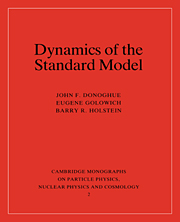Book contents
- Frontmatter
- Contents
- Preface
- I Inputs to the Standard Model
- II Interactions of the Standard Model
- III Symmetries and anomalies
- IV Introduction to effective lagrangians
- V Leptons
- VI Very low energy QCD – pions and photons
- VII Introducing kaons and etas
- VIII Kaons and the ΔS = 1 interaction
- IX Kaon mixing and CP violation
- X The Nc-1 expansion
- XI Phenomenological models
- XII Baryon properties
- XIII Hadron spectroscopy
- XIV Weak interactions of heavy quarks
- XV The Higgs boson
- XVI The electroweak gauge bosons
- A Appendix – Functional integration
- B Appendix – Some field theoretic methods
- C Appendix – Useful formulae
- References
- Index
IV - Introduction to effective lagrangians
Published online by Cambridge University Press: 06 January 2010
- Frontmatter
- Contents
- Preface
- I Inputs to the Standard Model
- II Interactions of the Standard Model
- III Symmetries and anomalies
- IV Introduction to effective lagrangians
- V Leptons
- VI Very low energy QCD – pions and photons
- VII Introducing kaons and etas
- VIII Kaons and the ΔS = 1 interaction
- IX Kaon mixing and CP violation
- X The Nc-1 expansion
- XI Phenomenological models
- XII Baryon properties
- XIII Hadron spectroscopy
- XIV Weak interactions of heavy quarks
- XV The Higgs boson
- XVI The electroweak gauge bosons
- A Appendix – Functional integration
- B Appendix – Some field theoretic methods
- C Appendix – Useful formulae
- References
- Index
Summary
The purpose of the effective lagrangian method is to represent in a simple way the dynamical content of a theory in the low energy limit, where effects of heavy particles can be incorporated into a few constants. The basic plan of attack is to write out the most general set of lagrangians consistent with the symmetries of the theory. At sufficiently low energies only one, or perhaps a few, of the lagrangians are relevant, and it is straightforward to read off the predictions of the theory.
Effective lagrangians are used in all aspects of the Standard Model and beyond, from QED to superstrings. Perhaps the best setting for learning about them is that of chiral symmetry. Besides being historically important in the development of effective lagrangian techniques, chiral symmetry is a rather subtle theory which can be used to illustrate all aspects of the method, viz. the low energy expansion, non-leading behavior, symmetry breaking and loops. In addition, the results can be tested directly by experiment since effective lagrangians provide a framework for understanding the very low energy limit of QCD.
Nonlinear lagrangians and the sigma model
The linear sigma model, introduced in Sects. I–3, I–5, provides a ‘user friendly’ introduction to effective lagrangians because all the relevant manipulations can be explicitly demonstrated. The Goldstone boson fields, the pions, are present at all stages of the calculation.
Information
- Type
- Chapter
- Information
- Dynamics of the Standard Model , pp. 97 - 125Publisher: Cambridge University PressPrint publication year: 1992
Accessibility standard: Unknown
Why this information is here
This section outlines the accessibility features of this content - including support for screen readers, full keyboard navigation and high-contrast display options. This may not be relevant for you.Accessibility Information
- 1
- Cited by
